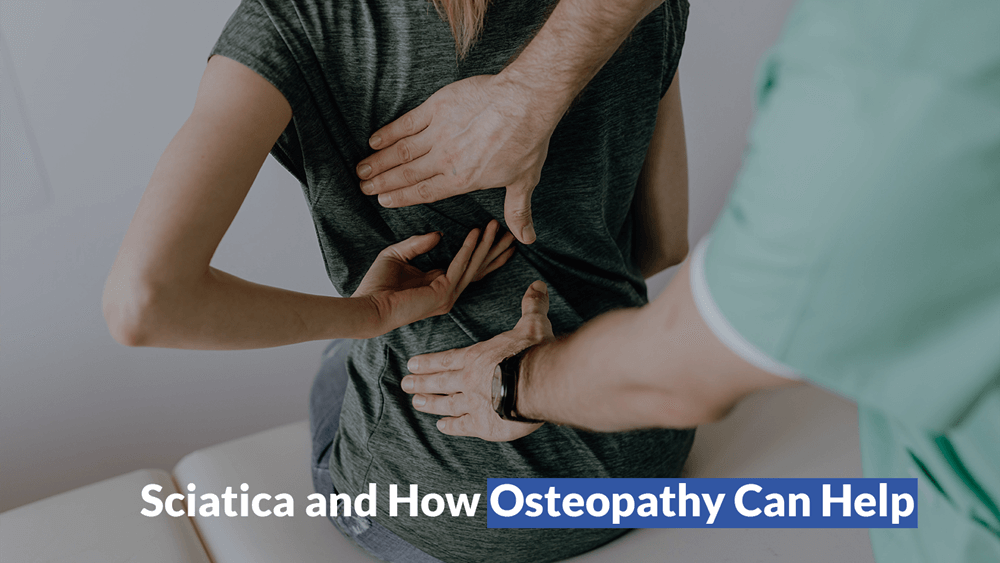Sciatica and How Osteopathy Can Help
Shooting pain down your leg? Numbness and tingling? Difficulty sitting or walking? You might be one of the millions suffering from sciatica. But, what is sciatica? Is it common? Is it easy to find an osteopath for sciatica pain? Keep reading to understand it all!
What is sciatica?
The famed Roman physician, Galen, described sciatica and its association with spinal problems. It’s not limited to a specific gender, but it tends to be more common in your 40s.
Research suggests that approximately 90% of sciatica cases stem from a spinal disc herniation exerting pressure on lumbar or sacral nerve roots.
The sciatic nerve, which is quite large, plays a vital role in controlling the muscles and providing sensation in your legs. Sciatica pain happens when something along its path causes trouble.
It’s 2023 and the story of sciatica persists, affecting an estimated 40% of adults at some point in their lives. The good news is that most people with sciatica pain get better within a few weeks. But, some individuals experience excruciating pain and debilitating symptoms. In the most severe cases, sciatica can lead to muscle weakness and loss of bladder or bowel control.
Even if your pain isn’t “officially” sciatica, our osteopath for sciatica pain can still treat your referred pain from other muscles and joints.
Causes of sciatica
Arthritis and Joint Degeneration: The wear and tear associated with arthritis can lead to bone spurs, pressing on nerves in the lower back.
Spinal stenosis: Narrowing of the spinal canal can put pressure on the sciatic nerve.
Bulging, Slipped, Prolapsed, or Herniated Disc: Issues with these discs can create pressure on the nerves in the spine.
Metabolic conditions: Diabetes and other metabolic conditions can damage nerves, including the sciatic nerve.
Trauma: Injuries to the spine or pelvis can damage the sciatic nerve.
Piriformis Muscle Tension/Piriformis Syndrome: When the piriformis muscle near the hip joint goes into spasm, it puts pressure on the sciatic nerve.
Pregnancy: Sciatica during pregnancy is common in the mid to late stages due to body changes.
Muscle Spasms: Spasms in the lower back, hamstring, or gluteal region can cause sciatic pain.
Spondylolisthesis: This spinal condition causes vertebrae to slip out of place, affecting the sciatic nerve.
Tumour or Infection: Though less common, a tumour or infection can create pressure on the sciatic nerve.
Other potential contributors
- Obesity: Excess weight can put additional strain on the spine and nerves.
- Smoking: Smoking can reduce blood flow to the discs in the spine, making them more likely to herniate.
- Poor posture: Sitting or standing with poor posture for long periods can put stress on the spine and nerves.
Signs and symptoms of sciatica
- Pain in the buttocks, legs, and feet
- Difficulty sleeping due to pain
- Weakness, numbness and tingling in the lower back
- Burning sensation in the affected leg
- Throbbing pain while sitting and aggravating pain with prolonged sitting or standing
- Pain when lifting heavy items
- Difficulty controlling urination or bowel movements (in severe cases)
Osteopathic examination of sciatica
An osteopathic examination for sciatic pain begins with a thorough case history, focusing on specific symptoms and their triggers. If sciatica is confirmed, your osteopath for sciatica pain will optimise the flexibility of muscles like the piriformis and buttock, along with addressing lower back muscles and joints for improved mobility and pain relief.
A skilled and expert osteopath for sciatica pain dives deep into past injuries, repetitive strain, surgeries, illnesses, and emotional stress impacting the spine, pelvis, and hips.
The osteopath Sydney will examine spine joints and muscles, identifying areas of tension and tenderness to identify inflammation or biomechanical imbalances.
Following a thorough analysis approach, the examination evaluates how the pelvis interacts with the spine, the coordination between leg and spine movements, and the upper body’s contribution to overall spine dynamics.
A competent osteopath for sciatica pain believes in relieving your pain and restoring improved movement and function. Always communicate openly with your osteopath throughout the process.
Osteopathic treatment for sciatica pain
Osteopathic treatment for sciatica pain has demonstrated effectiveness through extensive research, and our experienced osteopaths, each with years of clinical expertise, employ a gentle yet highly effective approach. This technique is particularly well-tolerated, even by patients in acute, severe pain, ensuring a balanced and comfortable experience during treatment. Whether dealing with acute or chronic sciatica, our approach aims to reach a balance point, mitigating the risk of exacerbating pain with minimal movement required from the patient.
Beyond addressing the spine, our osteopath for sciatica pain assesses other areas of the body contributing to compensatory issues for the spine. This comprehensive strategy recognises the interconnectedness of various body parts and ensures a thorough and tailored treatment plan.
Osteopaths may recommend post-treatment strategies to alleviate pain effectively while managing the sciatica pain. This could involve a combination of rest, the application of heat packs, gentle exercise and stretching regimens, specific supplements, and adjustments in posture to alleviate repetitive strain, especially in occupational settings. Additionally, if deemed necessary, an osteopath can facilitate referrals for spinal X-rays or other tests through your primary care provider.
The osteopathic treatment journey for sciatica begins with a consideration of your health history, examining any prior injuries or illnesses that may contribute to your condition. Subsequently, a detailed assessment of joints and muscles is conducted to identify the root cause and determine the optimal course of treatment.
Taking a holistic approach to healthcare, our osteopaths analyze how various areas of your body function together. Treatment focuses on reducing inflammation in affected regions, employing gentle techniques such as stretching, muscle and connective tissue release, massage, and muscle energy techniques, as well as mobilisation and articulation of joints and muscles. Dry needling may also be utilised.
Once pain is effectively managed, our osteopaths collaborate with you to transition into a restoration phase, incorporating targeted exercises to enhance overall movement and functionality. This personalised approach ensures a comprehensive and patient-centred osteopathic treatment for sciatica pain, facilitating no pain relief and an improved quality of life.
For more information about Osteopath Sydney Clinic, contact us today.


